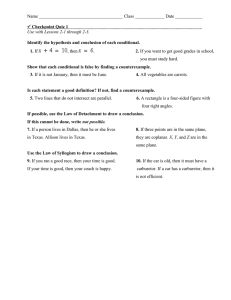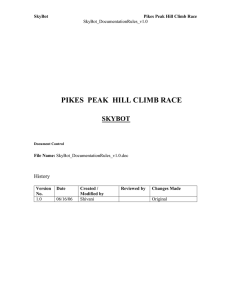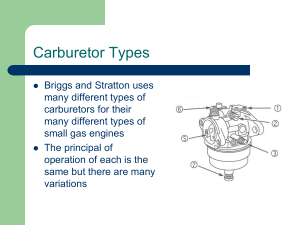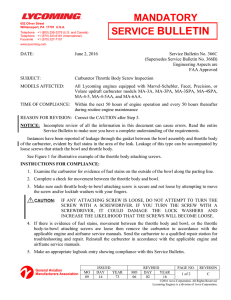SIB_201003_Carburetor_Icing_Prevention.
advertisement
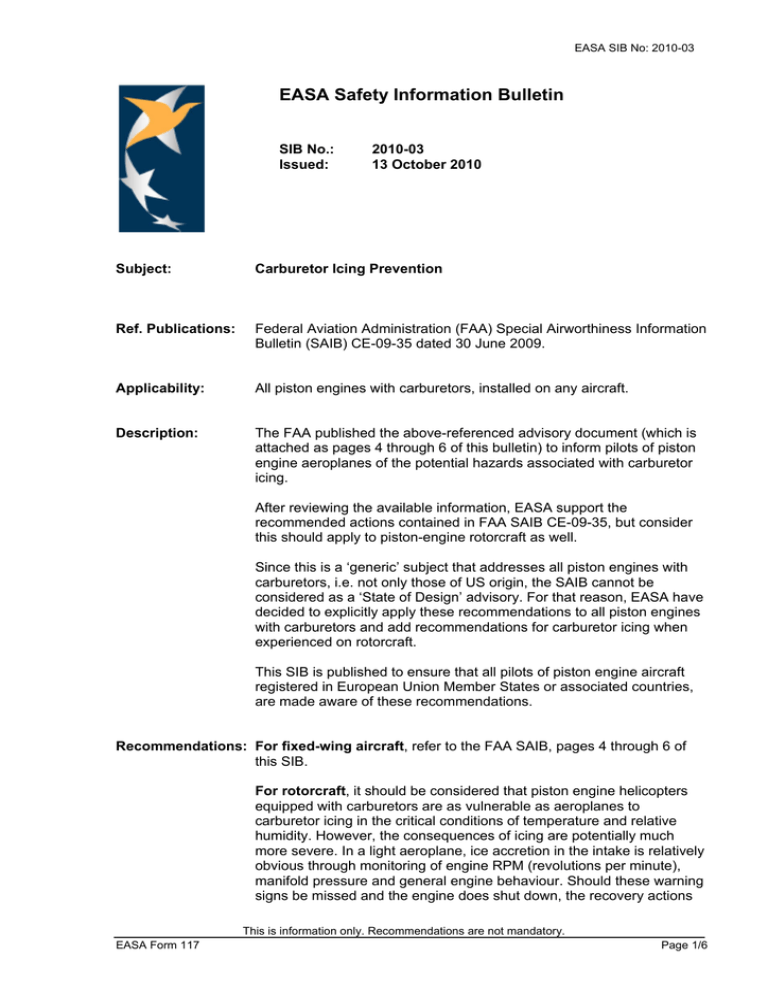
EASA SIB No: 2010-03 EASA Safety Information Bulletin SIB No.: Issued: 2010-03 13 October 2010 Subject: Carburetor Icing Prevention Ref. Publications: Federal Aviation Administration (FAA) Special Airworthiness Information Bulletin (SAIB) CE-09-35 dated 30 June 2009. Applicability: All piston engines with carburetors, installed on any aircraft. Description: The FAA published the above-referenced advisory document (which is attached as pages 4 through 6 of this bulletin) to inform pilots of piston engine aeroplanes of the potential hazards associated with carburetor icing. After reviewing the available information, EASA support the recommended actions contained in FAA SAIB CE-09-35, but consider this should apply to piston-engine rotorcraft as well. Since this is a ‘generic’ subject that addresses all piston engines with carburetors, i.e. not only those of US origin, the SAIB cannot be considered as a ‘State of Design’ advisory. For that reason, EASA have decided to explicitly apply these recommendations to all piston engines with carburetors and add recommendations for carburetor icing when experienced on rotorcraft. This SIB is published to ensure that all pilots of piston engine aircraft registered in European Union Member States or associated countries, are made aware of these recommendations. Recommendations: For fixed-wing aircraft, refer to the FAA SAIB, pages 4 through 6 of this SIB. For rotorcraft, it should be considered that piston engine helicopters equipped with carburetors are as vulnerable as aeroplanes to carburetor icing in the critical conditions of temperature and relative humidity. However, the consequences of icing are potentially much more severe. In a light aeroplane, ice accretion in the intake is relatively obvious through monitoring of engine RPM (revolutions per minute), manifold pressure and general engine behaviour. Should these warning signs be missed and the engine does shut down, the recovery actions This is information only. Recommendations are not mandatory. EASA Form 117 Page 1/6 EASA SIB No: 2010-03 by the pilot are straightforward. The aeroplane will normally enter a power off glide with no immediate crew action, the glide angle is relatively shallow and the pilot probably has time to restart the engine. In a helicopter, icing can develop quite insidiously and the effect on the engine is less obvious. Furthermore, should the engine stop, an immediate entry to autorotation is necessary to prevent catastrophic reduction of rotor RPM, and the descent rate, usually around 2 000 feet per minute, is such that there is rarely time to attempt a restart. Carburetor ice forms as a result of local temperature in the inlet, and of the relative humidity of the air. The tendency for ice to accrete in the inlet is as a result of 2 forms of cooling: • Venturi effect of the inlet air accelerating and then expanding through the throttle body • Evaporative cooling due to the vaporisation of fuel in the mixture Many helicopters operate with a de-rated engine in order to improve reliability and overhaul lives. For example, the Lycoming O-320 engine used in the Robinson R22 helicopter is nominally a 160 horse power (hp) engine, but is limited to a maximum of 124 hp continuous by a manifold pressure limitation. The consequence of this is that, unlike an aeroplane, the helicopter is rarely operated at full throttle. Even at “maximum power”, the throttle is only partly open. The possibility of carburetor icing at wide throttle openings is unlikely, but partial throttle openings increase the potential for icing due to the increased venturi effect. Current carburetor ice protection is typically by means of introducing warm air into the inlet – “Carb Heat”. This warms the intake air and is generally used in conjunction with an intake air temperature indicator to ensure that the temperature of the air is above that which is critical for icing. Because of the potential for icing in the cruise and even during high power phases of flight such as take off or climb, due to the effect of de-rating the engine, it is normally necessary to use partial heat at all times. Low power flight phases are most critical in carburetor icing conditions. As power is reduced and the throttle closes, the reduced intake area increases the venturi cooling effect and ice will build rapidly. Unless adequate carburetor heat is applied, the engine will stop. To insure against this eventuality, it is essential that full carburetor heating is applied well in advance of lowering the collective and closing the throttle to ensure that the intake is sufficiently warmed. If carburetor heat has not been used correctly and ice has been allowed to accrete, subsequent application of heat will cause the ice to melt very quickly and enter the engine. At best, this will result in short term rough running which can be unsettling. At worst, it could result in the engine stopping immediately. This could happen when the left hand is remote from the collective, manipulating the heat selector, and the consequences could be a failure to lower the collective in a timely manner and a catastrophic loss of rotor RPM. This is information only. Recommendations are not mandatory. EASA Form 117 Page 2/6 EASA SIB No: 2010-03 Helicopters are generally operated at constant rotor RPM which means that the engine is operating in a constant RPM/variable power manner. Piston engine helicopters are not equipped with an engine torque meter, and the only indication of power is an inlet manifold absolute pressure (MAP) indicator which is quite a coarse indication. In helicopters which are not equipped with rotor RPM governing, RPM will tend to vary as a result of control inputs and also as a result of manoeuvring effect on rotor inflow. These small variations are compensated for by means of constant small corrections to throttle position. In helicopters equipped with a governor, these throttle adjustments are made automatically. Should carburetor ice develop, the immediate effect will be a reduction in power and a loss of rotor RPM. In a governor equipped helicopter, this will be immediately corrected by the governor opening the throttle. Any RPM loss will be transient and not apparent to the crew. The power increase will be indicated by an increase in MAP, but on the coarse scale indicator, may not be immediately apparent to the pilot. In nongovernor aircraft, the tendency of rotor RPM to decrease may be masked by the general small variations in rotor RPM in flight and the instinctive throttle corrections applied by the pilot. Recommendations: For rotorcraft: To recognise carburetor icing, the signs include: • • • • Increasing power demand, either manually applied or by means of governor activity, to maintain rotor RPM. This should be apparent as gradually increasing MAP for steady state flight conditions. Reduction in rotor RPM, only if the engine has reached the maximum throttle position. Possible rough running engine Intake air temperature indicating in the critical regime, possibly due to incorrect use of carb heat, or ineffective carb heat. To prevent carburetor icing, the pilot should: • Follow any flight manual instructions on the use of carburetor heat explicitly • Ensure carb heat is functioning correctly during pre-flight ground checks • Apply full carburetor heat at least 20 seconds before lowering the collective to commence a descent Additionally, the pilot should: • Ensure that in manipulating the carburetor heat selector, the left hand is remote from the collective for as short a time as possible. • If rough running, or unexpected throttle limited rotor RPM reduction is experienced, apply full carburetor heat and be prepared to enter autorotation immediately, should the engine stop. . Contact: For further information contact the Airworthiness Directives, Safety Management & Research Section, Certification Directorate, EASA. E-mail: ADs@easa.europa.eu. This is information only. Recommendations are not mandatory. EASA Form 117 Page 3/6 SPECIAL AIRWORTHINESS INFORMATION BULLETIN FAA Aircraft Certification Service SAIB: Date: SUBJ: Carburetor Icing Prevention CE-09-35 06/30/2009 This is information only. Recommendations aren’t mandatory. Introduction This Special Airworthiness Information Bulletin is written to inform pilots of the potential hazards associated with carburetor icing. At this time, this airworthiness concern is not considered an unsafe condition that would warrant an airworthiness directive (AD) action under Title 14 of the Code of Federal Regulations (14 CFR part 39). Background There were 212 accidents attributed to carburetor icing between 1998 and 2007. Of these accidents, 13 resulted in fatalities. The certification requirements for carbureted airplanes require that a heated source of air be provided as mitigation for carburetor icing. The FAA and the Aircraft Owners and Pilots Association (AOPA) have addressed the subject of carburetor icing several times in various forms. Despite the certification requirements, and the information provided by the FAA and AOPA, the accident trend has remained fairly steady throughout the years. Pilots should be aware that carburetor icing doesn’t just occur in freezing conditions, it can occur at temperatures well above freezing temperatures when there is visible moisture or high humidity. Icing can occur in the carburetor at temperatures above freezing because vaporization of fuel, combined with the expansion of air as it flows through the carburetor, (Venturi Effect) causes sudden cooling, sometimes by a significant amount within a fraction of a second. Carburetor ice can be detected by a drop in rpm in fixed pitch propeller airplanes and a drop in manifold pressure in constant speed propeller airplanes. In both types, usually there will be a roughness in engine operation. The graph below shows the probability of carburetor icing for various temperature and relative humidity conditions: 1 Recommendations There are some steps a pilot can take to prevent, recognize, and respond to carburetor icing. To prevent carburetor icing, the pilot should: • Assure the proper functionality of the carburetor heat during the ground (Before Takeoff) check. • Use carburetor heat on approach and descent when operating at low power settings, or in conditions where carburetor icing is probable. To recognize carburetor icing, the warning signs are: • A drop in rpm in fixed pitch propeller airplanes. • A drop in manifold pressure in constant speed propeller airplanes. • In both types, usually there will be a roughness in engine operation. The pilot should respond to carburetor icing by applying full carburetor heat immediately. The engine may run rough initially for short time while ice melts. The above recommendations are general suggestions. The pilot should consult the AFM or the pilot's operating handbook for the proper use of carburetor heat. Included below are some references, and their associated links, for more information: • AC 20-113, Pilot Precautions and Procedures to be taken in Preventing Aircraft Reciprocating Engine Induction System and Fuel System Icing Problems http://rgl.faa.gov/Regulatory_and_Guidance_Library/rgAdvisoryCircular.nsf/0/F5BD7904E8 45409D862569AE00783347?OpenDocument&Highlight=carburetor%20icing • AC 91-51A, Effect of Icing on Aircraft Control and Airplane Deice and Anti-Ice Systems http://rgl.faa.gov/Regulatory_and_Guidance_Library/rgAdvisoryCircular.nsf/0/451296DBDF 212C81862569E70077C8F9?OpenDocument&Highlight=carburetor%20icing • AOPA Safety Advisor – Aircraft Icing http://www.aopa.org/asf/publications/sa11.pdf 2 • AOPA Safety Advisor – Aircraft Deicing and Anti-icing Equipment http://www.aopa.org/asf/publications/sa22.pdf For Further Information Contact Peter L. Rouse, Aerospace Engineer, Small Airplane Directorate; phone: (816) 329-4135; fax: (816) 329-4090; e-mail: peter.rouse@faa.gov. 3
